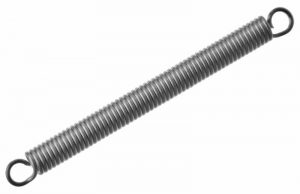
Springs are used in a wide variety of commercial and consumer applications. You can find them in machines, furniture, fixtures, electronics and more. While all springs serve as an energy storage device, though, they are available in different types. One of the most common types of springs is a mechanical extension spring. For a better understanding of mechanical extension springs and how they work, keep reading.
The Basics of Mechanical Extension Springs
Also known simply as an extension spring, a mechanical extension spring is an elastic device that’s designed to store mechanical energy when extended. As shown in the adjacent photo, mechanical extension springs consist of a long piece of coiled metal. There’s a single hook on each end, which allows the mechanical extension spring to connect to two objects or surfaces.
How Mechanical Extension Springs Work
Mechanical extension springs have a relatively simple method of operation. Like all springs, they are designed to store energy. When exposed to an outward pulling force, a mechanical extension spring will extend. In other words, it will become longer in response to this force. The mechanical extension spring will store this energy within its coiled metal.
Mechanical extension springs store energy under a tension loan. To use a mechanical extension spring, you’ll need to connect it to two objects or surfaces. There’s a hook on each end, which you can use to connect the mechanical extension spring. As the objects attempt to pull away from each other, a tension loan is created. The mechanical extension spring will then stretch while storing this tension load as mechanical energy.
Benefits of Mechanical Extension Springs
Mechanical extension springs are long-lasting. While they are available in different materials, most of them are made of a durable metal like stainless steel. Therefore, you don’t have to worry about them failing prematurely. Mechanical tension springs can last a long time — even when frequently exposed to a tension load.
They are also easy to use. They don’t require any fasters to install. Rather, you can install a mechanical extension spring by connecting its hooks to the objects or surfaces with which you intend to use it.
When used in manufacturing machines and equipment, mechanical extension springs can protect against damage. They can absorb vibrations while preventing the machine or equipment from moving. These are just a few benefits of mechanical extension springs.
